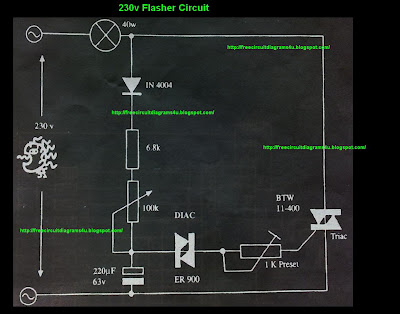
Bluish Flasher

The circuit demonstrates how a combination of a blue LED and a white LED can realistically imitate a camera flashlight. It utilizes the classic 555 integrated circuit (IC) in an innovative manner, functioning alternately in mono-stable and astable modes with minimal external components. Initially, capacitor C3 is uncharged, pulling output pin 3 to +12 V and illuminating the blue LED (D1) through resistor R3. As C3 charges via resistor R2, capacitor C1 accumulates charge through resistor R1 and diode D3. When the voltage on C3 reaches approximately 8 V (two-thirds of 12 V), pin 3 of the 555 drops low, which also causes pin 7 to drop low, turning on the white LED (D2) powered by C1. The energy from C1 depletes quickly, resulting in an exponential dimming of D2, simulating the behavior of a camera flash. As the output from the 555 drops low, the voltage on C3 decreases. Once it reaches 4 V (one-third of 12 V), the cycle restarts. Resistor R4 limits the current through the 555 to safe levels. Experimentation with high-brightness white LEDs, such as SDK’s AlInGaP LEDs, is encouraged, as they are reported to be three times brighter than standard white LEDs. Multiple blue LEDs can be connected in series, although this is not feasible for the white LED. For optimal visual effects, the blue and white LEDs should be closely mounted together. When installed near a vehicle's extra brake light, the bluish-white flash is likely to deter tailgaters. However, it is important to note that the legality of this circuit's application may vary by country.
The circuit employs a 555 timer IC configured to operate in a unique manner, allowing it to alternate between mono-stable and astable modes. This dual functionality is achieved through a careful selection of resistors and capacitors, specifically R1, R2, C1, and C3, which determine the timing intervals and charging characteristics of the LEDs. The blue LED (D1) serves as an initial indicator, lighting up immediately when the circuit is powered, thanks to the rapid charging of capacitor C3 through resistor R2. The design ensures that the blue LED illuminates first, providing a visual cue that the circuit is active.
Once C3 reaches the threshold voltage of about 8 V, the 555 timer transitions, causing the output at pin 3 to drop. This transition triggers the white LED (D2) to light up, utilizing the charge stored in capacitor C1. The rapid discharge of C1 results in a quick dimming of D2, mimicking the brief burst of light produced by a camera flash. The exponential decay in brightness is a critical aspect of the design, as it closely resembles the natural behavior of a camera flash, thereby enhancing the realism of the effect.
The inclusion of resistor R4 is vital for protecting the 555 timer from excessive current, ensuring reliable operation over extended periods. The circuit's flexibility allows for experimentation with various LED types, particularly high-intensity models, which can significantly enhance the visual output. For instance, substituting standard white LEDs with high-brightness AlInGaP variants can yield a more striking effect, making the circuit suitable for applications where visibility is paramount.
The arrangement of the LEDs is also crucial for achieving the desired visual impact. Placing the blue and white LEDs in close proximity not only maximizes the aesthetic effect but also ensures that the emitted light appears cohesive. This configuration is particularly effective when integrated into automotive lighting systems, where the unique bluish-white flash can serve as a safety feature, alerting nearby drivers.
In conclusion, this circuit design provides an innovative approach to LED illumination, effectively utilizing the 555 timer IC to create a realistic camera flash simulation. The careful selection of components, along with thoughtful placement of the LEDs, results in a visually striking effect that can enhance safety in various applications. However, users should remain aware of the legal implications of using such circuits in automotive lighting, as regulations may differ across regions.Firstly, it demonstrates how the combination of a blue and a white LED can be used to give a realistic imitation of a camera flashlight. Secondly, the good old 555 IC is used in a way many of you may never have seen before alternately mono-stable / astable without too much in the way of external parts.
Initially C3 will be empty, pulling output pi n 3 to +12 V and causing the blue LED, D1, to light via R3. Next, C3 will charge up via R2. Meanwhile C1 has been building up charge through R1 and D3. If the voltage on C3 reaches about 8 V (two-thirds of 12 V), pin 3 of the 555 will drop Low. So does pin 7, causing the white LED to light, pulling its energy from C1. This energy drops quickly, causing D2 to dim in an exponentially decaying fashion, just like a camera flashlight. Now, because the 555`s output has dropped Low, the voltage on C3 will decrease as well. Ad soon as a level of 4 V is reached (one third of 12 V), the above cycle is repeated. Resistor R4 limits the current through the 555 to safe levels. You may want to experiment with the latest hyper-bright white LEDs. SDK`s AlInGaP LEDs, for example, are claimed to light three times as brightly as regular white LEDs. A number of blue LEDs may be connected in series instead of just one as shown in the circuit diagram.
Unfortunately, that is not possible at the white` side. For the best visual effect, the white blue LEDs should be mounted close together. When fitted close to the extra brake light in your car, the bluish white flash is sure to make even persistent tailgaters back off. Note however that this use of the circuit may not be legal in all countries. 🔗 External reference
The circuit employs a 555 timer IC configured to operate in a unique manner, allowing it to alternate between mono-stable and astable modes. This dual functionality is achieved through a careful selection of resistors and capacitors, specifically R1, R2, C1, and C3, which determine the timing intervals and charging characteristics of the LEDs. The blue LED (D1) serves as an initial indicator, lighting up immediately when the circuit is powered, thanks to the rapid charging of capacitor C3 through resistor R2. The design ensures that the blue LED illuminates first, providing a visual cue that the circuit is active.
Once C3 reaches the threshold voltage of about 8 V, the 555 timer transitions, causing the output at pin 3 to drop. This transition triggers the white LED (D2) to light up, utilizing the charge stored in capacitor C1. The rapid discharge of C1 results in a quick dimming of D2, mimicking the brief burst of light produced by a camera flash. The exponential decay in brightness is a critical aspect of the design, as it closely resembles the natural behavior of a camera flash, thereby enhancing the realism of the effect.
The inclusion of resistor R4 is vital for protecting the 555 timer from excessive current, ensuring reliable operation over extended periods. The circuit's flexibility allows for experimentation with various LED types, particularly high-intensity models, which can significantly enhance the visual output. For instance, substituting standard white LEDs with high-brightness AlInGaP variants can yield a more striking effect, making the circuit suitable for applications where visibility is paramount.
The arrangement of the LEDs is also crucial for achieving the desired visual impact. Placing the blue and white LEDs in close proximity not only maximizes the aesthetic effect but also ensures that the emitted light appears cohesive. This configuration is particularly effective when integrated into automotive lighting systems, where the unique bluish-white flash can serve as a safety feature, alerting nearby drivers.
In conclusion, this circuit design provides an innovative approach to LED illumination, effectively utilizing the 555 timer IC to create a realistic camera flash simulation. The careful selection of components, along with thoughtful placement of the LEDs, results in a visually striking effect that can enhance safety in various applications. However, users should remain aware of the legal implications of using such circuits in automotive lighting, as regulations may differ across regions.Firstly, it demonstrates how the combination of a blue and a white LED can be used to give a realistic imitation of a camera flashlight. Secondly, the good old 555 IC is used in a way many of you may never have seen before alternately mono-stable / astable without too much in the way of external parts.
Initially C3 will be empty, pulling output pi n 3 to +12 V and causing the blue LED, D1, to light via R3. Next, C3 will charge up via R2. Meanwhile C1 has been building up charge through R1 and D3. If the voltage on C3 reaches about 8 V (two-thirds of 12 V), pin 3 of the 555 will drop Low. So does pin 7, causing the white LED to light, pulling its energy from C1. This energy drops quickly, causing D2 to dim in an exponentially decaying fashion, just like a camera flashlight. Now, because the 555`s output has dropped Low, the voltage on C3 will decrease as well. Ad soon as a level of 4 V is reached (one third of 12 V), the above cycle is repeated. Resistor R4 limits the current through the 555 to safe levels. You may want to experiment with the latest hyper-bright white LEDs. SDK`s AlInGaP LEDs, for example, are claimed to light three times as brightly as regular white LEDs. A number of blue LEDs may be connected in series instead of just one as shown in the circuit diagram.
Unfortunately, that is not possible at the white` side. For the best visual effect, the white blue LEDs should be mounted close together. When fitted close to the extra brake light in your car, the bluish white flash is sure to make even persistent tailgaters back off. Note however that this use of the circuit may not be legal in all countries. 🔗 External reference
Warning: include(partials/cookie-banner.php): Failed to open stream: Permission denied in /var/www/html/nextgr/view-circuit.php on line 713
Warning: include(): Failed opening 'partials/cookie-banner.php' for inclusion (include_path='.:/usr/share/php') in /var/www/html/nextgr/view-circuit.php on line 713





